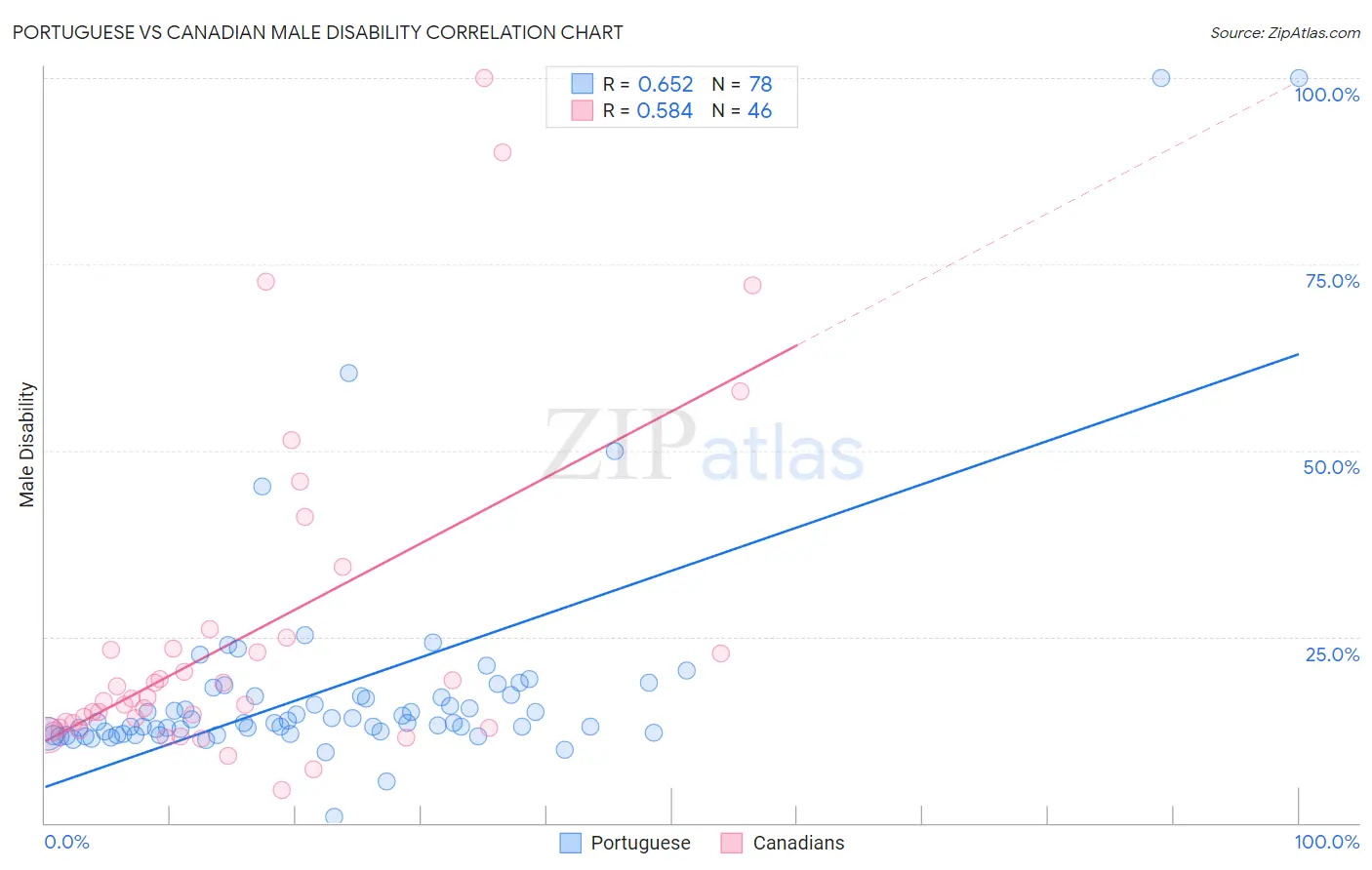Portuguese vs Canadian Male Disability
COMPARE
Portuguese
Canadian
Male Disability
Male Disability Comparison
Portuguese
Canadians
12.3%
MALE DISABILITY
0.1/ 100
METRIC RATING
268th/ 347
METRIC RANK
12.2%
MALE DISABILITY
0.2/ 100
METRIC RATING
263rd/ 347
METRIC RANK
Portuguese vs Canadian Male Disability Correlation Chart
The statistical analysis conducted on geographies consisting of 450,223,717 people shows a significant positive correlation between the proportion of Portuguese and percentage of males with a disability in the United States with a correlation coefficient (R) of 0.652 and weighted average of 12.3%. Similarly, the statistical analysis conducted on geographies consisting of 437,467,484 people shows a substantial positive correlation between the proportion of Canadians and percentage of males with a disability in the United States with a correlation coefficient (R) of 0.584 and weighted average of 12.2%, a difference of 0.68%.

Male Disability Correlation Summary
| Measurement | Portuguese | Canadian |
| Minimum | 0.74% | 4.4% |
| Maximum | 100.0% | 100.0% |
| Range | 99.3% | 95.6% |
| Mean | 18.0% | 25.0% |
| Median | 13.5% | 16.5% |
| Interquartile 25% (IQ1) | 12.0% | 12.7% |
| Interquartile 75% (IQ3) | 17.1% | 23.4% |
| Interquartile Range (IQR) | 5.1% | 10.7% |
| Standard Deviation (Sample) | 15.8% | 21.6% |
| Standard Deviation (Population) | 15.7% | 21.3% |
Demographics Similar to Portuguese and Canadians by Male Disability
In terms of male disability, the demographic groups most similar to Portuguese are Czechoslovakian (12.3%, a difference of 0.0%), Spaniard (12.3%, a difference of 0.090%), Immigrants from Germany (12.3%, a difference of 0.13%), Hawaiian (12.3%, a difference of 0.18%), and Immigrants from Portugal (12.3%, a difference of 0.19%). Similarly, the demographic groups most similar to Canadians are Nepalese (12.2%, a difference of 0.030%), Norwegian (12.2%, a difference of 0.20%), Slavic (12.2%, a difference of 0.21%), Immigrants from Portugal (12.3%, a difference of 0.49%), and Hawaiian (12.3%, a difference of 0.51%).
| Demographics | Rating | Rank | Male Disability |
| Chinese | 0.4 /100 | #255 | Tragic 12.1% |
| Swiss | 0.3 /100 | #256 | Tragic 12.1% |
| Europeans | 0.3 /100 | #257 | Tragic 12.1% |
| Basques | 0.3 /100 | #258 | Tragic 12.1% |
| Belgians | 0.3 /100 | #259 | Tragic 12.1% |
| Swedes | 0.3 /100 | #260 | Tragic 12.1% |
| Slavs | 0.2 /100 | #261 | Tragic 12.2% |
| Norwegians | 0.2 /100 | #262 | Tragic 12.2% |
| Canadians | 0.2 /100 | #263 | Tragic 12.2% |
| Nepalese | 0.2 /100 | #264 | Tragic 12.2% |
| Immigrants | Portugal | 0.1 /100 | #265 | Tragic 12.3% |
| Hawaiians | 0.1 /100 | #266 | Tragic 12.3% |
| Immigrants | Germany | 0.1 /100 | #267 | Tragic 12.3% |
| Portuguese | 0.1 /100 | #268 | Tragic 12.3% |
| Czechoslovakians | 0.1 /100 | #269 | Tragic 12.3% |
| Spaniards | 0.1 /100 | #270 | Tragic 12.3% |
| Scandinavians | 0.1 /100 | #271 | Tragic 12.3% |
| Hmong | 0.0 /100 | #272 | Tragic 12.5% |
| Native Hawaiians | 0.0 /100 | #273 | Tragic 12.5% |
| Hopi | 0.0 /100 | #274 | Tragic 12.5% |
| Fijians | 0.0 /100 | #275 | Tragic 12.6% |